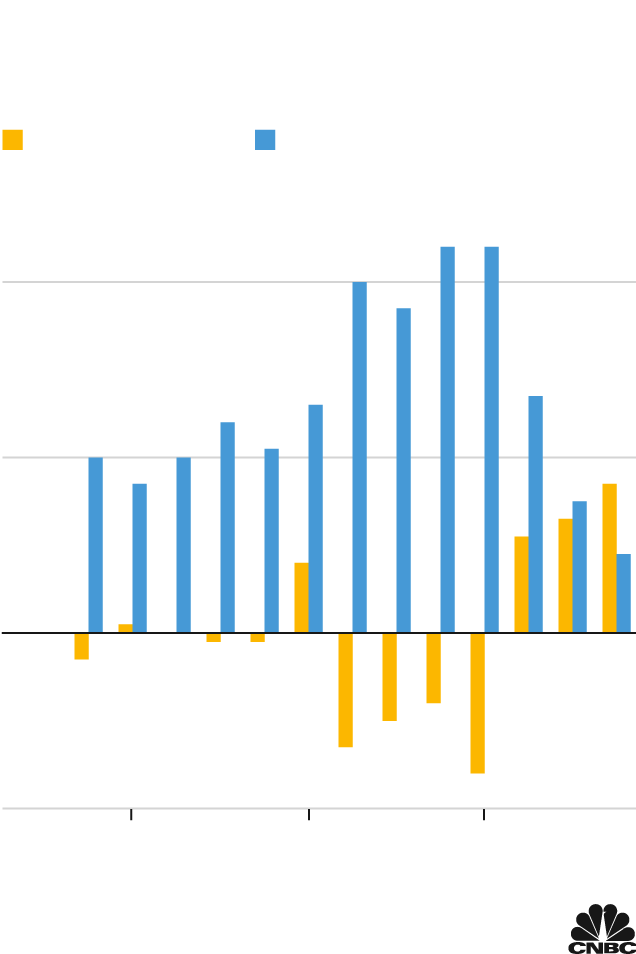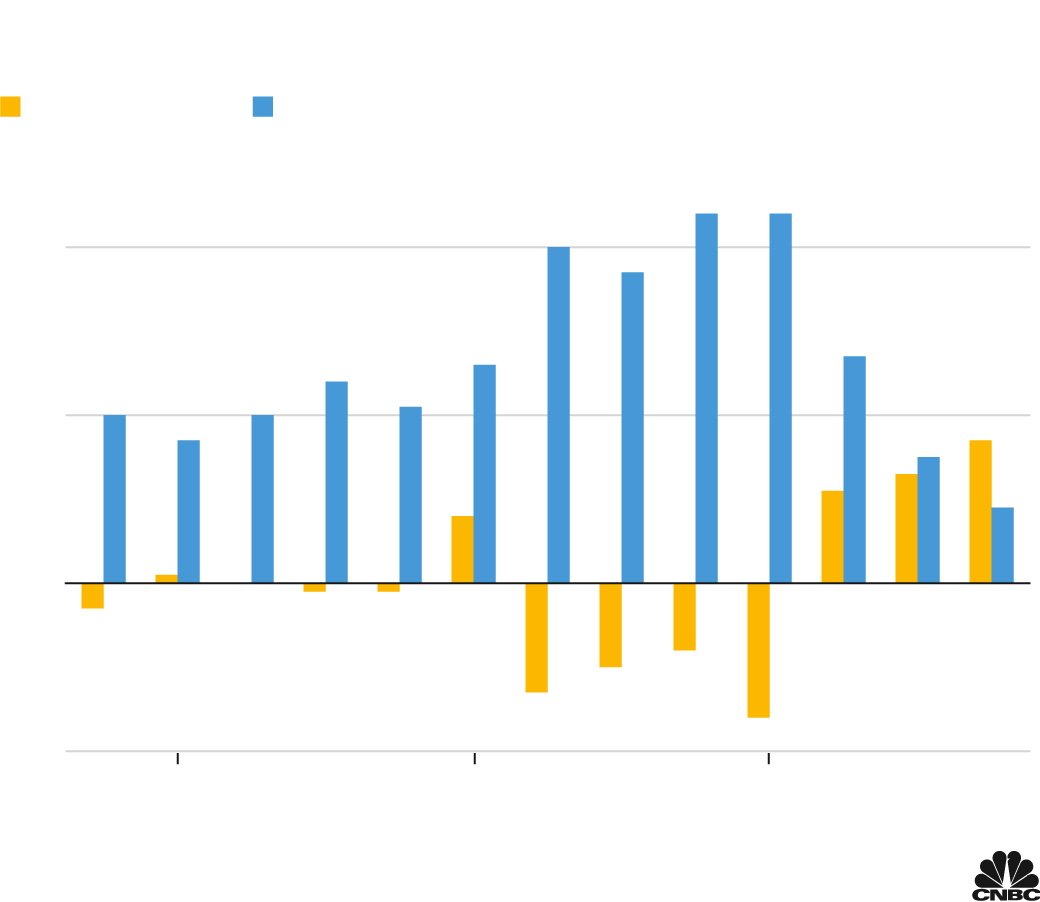Amazon has spent almost three decades perfecting the art of bringing everything imaginable to your doorstep in the shortest amount of time, at the lowest possible price. By almost any measure, it’s been one of the greatest corporate successes in history.
But despite Amazon’s unquestioned dominance in e-commerce, one giant market has proven particularly vexing: groceries.
Amazon has introduced a dizzying array of services — Prime Now, Fresh, Go and others — in its effort to become a giant in the $750 billion U.S. grocery market. In 2017, it spent $13.7 billion to acquire Whole Foods, a price tag more than 10 times higher than Amazon had paid in any prior deal.
Still, it’s just a niche player in the industry. As of mid-December, Amazon.com and Whole Foods accounted for a combined 2.4% of the grocery market over the past 12 months, while Walmart controlled 18%, according to research firm Numerator. Amazon’s delivery services have struggled to stand out in a crowded field, while the Go automated convenience stores have been deprioritized, according to people familiar with the company’s strategy.
On founder Jeff Bezos’ watch, shareholders expressed little concern about this corner of the Amazon empire. The company’s stock price soared almost 400% in his last five years at the helm, boosted by e-commerce growth and a booming cloud business.
The story has changed since July, when Bezos was succeeded as CEO by longtime cloud chief Andy Jassy. The stock has dropped by about 13% in that time and was the worst performer in the Big Tech group last year. Amazon just reported its slowest growth rate for any quarter since 2001.
That may give investors a reason to start looking for things they don’t like. One area of scrutiny could be Amazon’s physical stores unit, which includes Whole Foods and Fresh stores. It saw lower sales in 2021 than in 2018, even as its footprint of leases expanded by 17% over that stretch.
Amazon quarterly sales, change from prior year
Physical stores
Total sales
40%
20
0
−20
2019
2020
2021
Source: Company filings. As of Q4 2021.
Amazon quarterly sales, change
from prior year
Physical stores
Total sales
40%
20
0
−20
2019
2020
2021
Source: Company filings. As of Q4 2021.
Amazon quarterly sales, change from prior year
Physical stores
Total sales
40%
20
0
−20
2019
2020
2021
Source: Company filings. As of Q4 2021.
“Amazon’s all about the cloud, e-commerce and entertainment,” said Jake Dollarhide, CEO of Longbow Asset Management, which has counted Amazon has a “core holding” since 2011. “It’s almost like the grocery business is an expensive hobby.”
Competition is everywhere. Entrenched players such as Walmart, Target, Kroger and Albertsons are getting savvier with digital offerings, thanks to the pandemic jolt. Meanwhile, Instacart, Uber, DoorDash and Gopuff are throwing money at speedy delivery, Amazon’s sweet spot.
With Jassy now plotting the road ahead for Amazon and its disjointed portfolio of high-cost grocery assets, CNBC talked with insiders and former employees about how the company got to this point and where it goes from here.
Most of the people who agreed to be interviewed did so on condition that they not be named because they weren’t authorized to speak about their experiences or they feared retribution from the company.
They portrayed an environment of intense internal competition for resources and said culture clashes ensued when groups came together. Part of that is intentional, as Bezos fostered a workplace of competing ideas. It’s also created chaos and a lack of clear direction.
Amazon declined to provide commentary on the record for this story or make any executives available for interviews.
Fresh vs. Prime Now
The year 2017 marked an inflection point for Amazon’s grocery strategy.
Late that year, two rising stars at Amazon were called into a meeting to rethink how the company delivers groceries.
Amazon was pouring money into the Prime Now rapid delivery program and the Amazon Fresh grocery delivery service.
Bezos wasn’t happy. He saw Fresh and Prime Now as too similar to justify the hefty investment that each required. That problem was amplified by the Whole Foods acquisition, which made Amazon’s grand ambitions clear to the competition and led investors to dump shares of other grocery chains.
Amazon leadership summoned Stephenie Landry, who ran Prime Now, and Ben Hartman, head of Amazon Fresh, to the company’s Seattle headquarters. They were told to prepare for a “bake-off” that would determine the path forward for the company’s online grocery business, according to people familiar with the matter.
It was a pivotal moment for Amazon. The Fresh delivery service had been around since 2007, when longtime executive Doug Herrington, a former vice president at dot-com grocery flameout Webvan, launched an initiative to drive fresh fruits, vegetables, meat and milk in temperature-controlled tote bags to some residents in the Seattle suburb of Mercer Island.
Andrea Leigh remembers the early days of the grind, trying to make it in the low-margin business. Having worked in Amazon’s media, grocery and gourmet and baby categories, Leigh was on maternity leave in 2010 when she was brought back to help Fresh make money so it could grow beyond Seattle.
“We had been working on Fresh for three years at that point and we hadn’t gotten the model profitable,” Leigh said. “There was a real interest and desire to expand.”
One idea was to steer grocery shoppers toward higher-priced items in other categories. It could be a pair of headphones or a last-minute birthday gift.
Leigh built an algorithm that identified top-selling items in Seattle, thinking it could improve Fresh’s general merchandise assortment. The software didn’t always work as intended.
One time Amazon ended up ordering a bunch of life-sized horsehead masks, after the algorithm flagged them as the city’s top toy. The algorithm didn’t adjust to recognize that Halloween was approaching.
By the time Fresh launched outside Seattle, opening a Los Angeles operation in 2013, Prime Now was on the horizon and would soon pose a challenge from the inside.
Fresh had been around for six years, but Prime Now had a distinct advantage. It was being run by Landry, who had served as a shadow advisor to Jeff Wilke, Bezos’ right-hand man. She was handpicked for Prime Now by Dave Clark, the top retail boss, after she created a membership program geared toward expectant mothers that impressed leadership.
Prime Now was also unprofitable, but the team proved it could make deliveries with increasing efficiency, and Amazon executives were confident it could scale, two former Prime Now employees said.
By 2016, Prime Now was available in dozens of cities across the country, and was entering Fresh’s turf, adding fresh food to its delivery options and going beyond Target-like products such as shampoo and paper towels, a former Prime Now employee said.
Two former employees described it as a corporate rivalry, and discussions began about whether the groups should continue along their separate ways.
With Prime Now and Fresh both in need of continuing capital and Whole Foods suddenly added to the mix, the bake-off ensued between Landry and Hartman.
Landry’s side won. Prime Now, which was just three years old at the time, took over control of Fresh. Hartman, who started at Amazon as a product manager in 2002, left groceries for a role in the European consumer business.
Landry, who retained the title vice president of grocery, kept the Fresh branding because it appeared to resonate better with consumers than Prime Now, according to people with knowledge of the matter. Fresh was clearly associated with groceries, while Prime Now could be easily confused with Amazon’s Prime subscription service.
Amazon discontinued the Prime Now app and website last year, bringing all online grocery orders under Fresh or Whole Foods.
The rivalry remained as the combined teams struggled to work together. One former Prime Now employee said the Fresh team was demoralized and unhappy about being brought under Landry’s leadership.
Meshing Amazon’s online and in-person strategy is proving to be an even bigger challenge.
The upscale grocery gamble
Prior to 2017, Amazon had already moved into brick-and-mortar retail with bookstores and pop-up mall kiosks, but Whole Foods was its first real foray into dedicated grocery stores.
Whole Foods also represented an opportunity for Amazon to showcase its products and technology, creating the best blend of e-commerce and in-person shopping. It sounded great in theory. In practice, Amazon faced major cultural and integration challenges.
Founded in 1980 in Austin, Texas, Whole Foods grew up a universe away from the tech hubs of Seattle and Silicon Valley. The company relished the local experience. Regional managers had a level of autonomy over their stores, down to the artists they hired to illustrate chalkboard signs, according to a former Whole Foods senior manager.
Amazon had its own ideas. Immediately after the deal closed, it focused on adding Prime Now’s speedy deliveries to the Whole Foods menu to reach a new set of customers.
Prime Now eventually made it into Whole Foods stores nationwide. But along the way, Amazon discovered the store layouts made it difficult to efficiently pick and process orders, a former Prime Now employee said.
So rather than relying on Whole Foods, Amazon explored creating a new grocery chain that combined lessons from Whole Foods with Amazon’s logistics expertise, real estate footprint and Prime Now warehouses, which placed limited inventory close to customers.
Steve Kessel, a longtime Amazon executive who had built the original Kindle before taking over physical stores, conceived of a supermarket where grocery delivery and pickup didn’t interfere with in-store shopping. Consumers could visit the store and still be delighted, while sections of the facility would be dedicated to deliveries and curbside pickup.
Kessel chose Jeff Helbling, a former Kindle vice president, to lead what would become Amazon Fresh stores.
In 2020, the first Amazon Fresh opened in the upscale Los Angeles neighborhood of Woodland Hills. It featured a mix of supermarket staples and prepared foods, as well as meats and seafood. In a separate area, consumers could return Amazon orders or buy Fire tablets.
Amazon Fresh supermarkets now number more than 20 across six states and Washington, D.C. Many are in buildings formerly occupied by regional supermarkets, such as Fairway Market and Giant Food.
In less than two years, the stores have already proven they can be much more efficient than their rivals in the business.
A roughly 35,000-square-foot supermarket typically can fulfill an average of 120 to 150 online orders a day. Jordan Berke, CEO of Tomorrow Retail Consulting, said Amazon Fresh stores are capable of handling order volume that’s three to five times higher at the time of launch. He said those figures are based on discussions with company employees.
In addition to the beneficial store design, Berke said that Fresh stores also see more online demand because of the Prime subscriber base.
They appear to be a hit with consumers. Traffic at eight Fresh stores remained consistent between March, around the time they opened, and September, according to a report published in October by retail analytics firm Placer.ai.
“The relative steadiness in visits shows that a core group of customers have added a trip to Amazon Fresh to their regular grocery routine, indicating that Amazon Fresh has successfully integrated into the grocery mix for the neighborhoods it entered,” the firm wrote.
But leadership has been in flux. Kessel announced his departure in late 2019, a move that was viewed as a major shakeup, people familiar with the matter said. Cameron Janes, who had been vice president of physical retail, left in November.
Amazon didn’t officially replace Kessel until this month, when Tony Hoggett, a veteran of British supermarket chain Tesco, was brought on to lead physical stores. Hoggett’s hiring was seen as an acknowledgment by some employees that the company needed more brick-and-mortar experience.
Landry reports to Hoggett, a sign of Amazon’s focus on the expansion of physical stores.
Go stores not a smash hit
Grocery stores and deliveries are all part of what Amazon calls F3, or Fresh Food Fast.
There’s one piece of its grocery portfolio that’s orphaned from that group: Amazon Go.
In 2012, Kessel tapped two Amazon retail veterans, Gianna Puerini and Dilip Kumar, to spearhead a top-secret project that would evolve into an effort to automate the convenience store, removing the hassle of waiting in lines.
Puerini and Kumar’s team developed a cashier-free store, packed with cameras and sensors that use artificial intelligence to identify and track sandwiches, yogurt and chips picked off the shelves.
The first Amazon Go opened to the public in 2018 at the company’s Seattle headquarters.
Four years later there are 24 stores, a fraction of the 3,000 the company was looking to open by 2021, according to a Bloomberg report after the initial launch.
They’re heavily concentrated in dense, urban areas, which are ideal locations for busy office workers during the lunchtime rush. But when offices closed their doors during the coronavirus pandemic and cities went into lockdown, traffic disappeared and Amazon tempered its expansion efforts.
Last month, the company announced plans to open its first Go store in the suburbs, in the town of Mill Creek, Washington, about 30 minutes north of Seattle.
Former Amazon employees said the overall grocery strategy has moved further in the direction of bigger stores and away from Go marts.
The Go division has become more of a tech incubator. Its Just Walk Out technology is being tested at some Fresh locations, Whole Foods stores and full-size Go Grocery stores, which have since been rebranded under the Fresh label.
Last month, Business Insider reported that Amazon has considered selling gas at Go convenience stores, along with lottery tickets and pharmaceuticals. The company has reportedly acknowledged that selling fuel could bring risks, including a potential conflict with its various climate initiatives.
The future of Go is cloudy. Removed from the grocery division, Go falls under the physical stores unit, managed by Kumar, a former Go employee said. Kumar reports to Hoggett, while Puerini has since retired from the company.
The Go unit includes other types of Amazon retailers such as the 4-star stores and bookstores, but also oversees development of the Just Walk Out technology and other products such as the Amazon One contactless payment system.
“It’s just a bunch of shots on goal trying to figure it out,” said Scott Jacobson, a managing director at Madrona Venture Group in Seattle and a former Amazon employee who helped launch the Kindle. “It’s not clear what the future is yet.”
Just a novelty?
Go initially was kept separate from the grocery division because the focus was more on the technology it was building, the former Go employee said.
But as Go’s operations expand, they start to encroach on Amazon’s other grocery assets, potentially creating the kind of internal competition that the 2017 bake-off was supposed to solve.
What’s clear to people inside the grocery business is that the investment and talent focus is on Fresh. However, the strategy remains convoluted. Whole Foods has more than 500 stores nationwide. Amazon Fresh has opened 38 stores in the U.S. and U.K. in less than two years. And there are two dozen Go convenience stores.
Jacobson said that, unlike its e-commerce and cloud, Amazon’s grocery business is a novelty that hasn’t created any real differentiation in grocery to separate it from the many competitors.
“The problem with a novelty is if it’s not fundamentally more valuable, then that’s all it is — a novelty,” Jacobson said.
Investors haven’t loudly questioned the process yet, but the macro environment is changing. Money managers have been rotating out of tech on inflation and interest rate concerns, sending Amazon’s stock in January to its worst monthly drop since 2018. According to a Wall Street Journal report this week, billionaire activist investor Dan Loeb, who’s been adding to his Amazon holdings, told investors on a private call that he sees about $1 trillion in untapped value at the company.
Like Bezos before him, Jassy avoids the quarterly earnings calls, so it was left up to finance chief Brian Olsavsky to update investors after fourth-quarter results earlier this month.
Groceries weren’t a big topic, but an analyst did ask Olsavsky about same-day delivery and how the company’s investments are paying off.
“We feel good about where we are,” Olsavsky said. With respect to trying to deliver groceries in one to two hours and Prime packages in one to two days, he said, “We’re continuing to build capacity that enables us to hit those cutoffs.”
— CNBC’s Nate Rattner contributed to this story.
WATCH: Cloud computing and advertising offset slowdown in e-commerce










